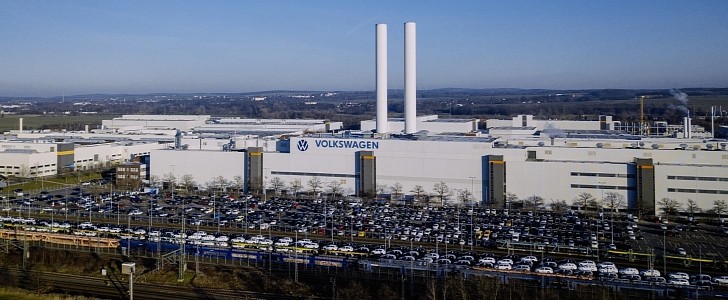We often mention Zwickau whenever we talk about an MEB vehicle. Until very recently, it was mandatory: the German plant was the only one producing Volkswagen’s electric cars. Not long ago, it only made combustion-engined cars such as the Golf. Fully Charged visited it to try to describe the transformation it had to go through.
More than €1.2 billion ($1.36 billion at the current exchange rate) were invested in updating the factory to produce MEB vehicles. That’s more than enough to build another plant, which shows the main difference between legacy carmakers and startups or new companies. While the latter ones have no previous commitments, legacy companies have employees, agreements, and even massive buildings that they cannot just leave behind.
One-third of that money (€400 million, or $454 million) was invested solely in the body shop. According to Stefan Loth, that’s because electric cars are very diverse from ICE vehicles. The chairman of the board of management for VW Saxony also mentioned that EVs could be easier to produce, even if that requires retraining their staff to the new reality these cars offer.
This is when the main point of criticism about the Fully Charged video emerged. Jack Scarlett tries to explain how contrasting EVs and ICE cars can be by mentioning that everything above the naked MEB platform “is for your feet.” A little further, he says that “you’d see room in the front taken by the engine.” The truth is that the MEB platform takes room in the front with the electric motor because MEB cars offer no frunk.
That was probably a compromise Volkswagen had to do to make these cars more easily serviceable. Whatever the reason was, the fact is that MEB cars are not a good example of space usage. They are better than adapted ICE platforms that use electric powertrains, for sure, but far from what Tesla, Ford, and Lucid offer in terms of roominess.
The video presenter then shows Zwickau’s hall of batteries. It can store up to 3,000 battery packs – not cells, as Scarlett says – simultaneously, which is pretty impressive. The video also reveals that Volkswagen even created an escape room to train its workers about why the company is pursuing electric mobility and why they should support that move. Interesting.
When you have the time for that, watching it is undoubtedly a richer experience than reading about it. Make sure you have a look at the video below to learn more about the challenges of going from combustion-engined car production to making only EVs.
One-third of that money (€400 million, or $454 million) was invested solely in the body shop. According to Stefan Loth, that’s because electric cars are very diverse from ICE vehicles. The chairman of the board of management for VW Saxony also mentioned that EVs could be easier to produce, even if that requires retraining their staff to the new reality these cars offer.
This is when the main point of criticism about the Fully Charged video emerged. Jack Scarlett tries to explain how contrasting EVs and ICE cars can be by mentioning that everything above the naked MEB platform “is for your feet.” A little further, he says that “you’d see room in the front taken by the engine.” The truth is that the MEB platform takes room in the front with the electric motor because MEB cars offer no frunk.
That was probably a compromise Volkswagen had to do to make these cars more easily serviceable. Whatever the reason was, the fact is that MEB cars are not a good example of space usage. They are better than adapted ICE platforms that use electric powertrains, for sure, but far from what Tesla, Ford, and Lucid offer in terms of roominess.
The video presenter then shows Zwickau’s hall of batteries. It can store up to 3,000 battery packs – not cells, as Scarlett says – simultaneously, which is pretty impressive. The video also reveals that Volkswagen even created an escape room to train its workers about why the company is pursuing electric mobility and why they should support that move. Interesting.
When you have the time for that, watching it is undoubtedly a richer experience than reading about it. Make sure you have a look at the video below to learn more about the challenges of going from combustion-engined car production to making only EVs.













